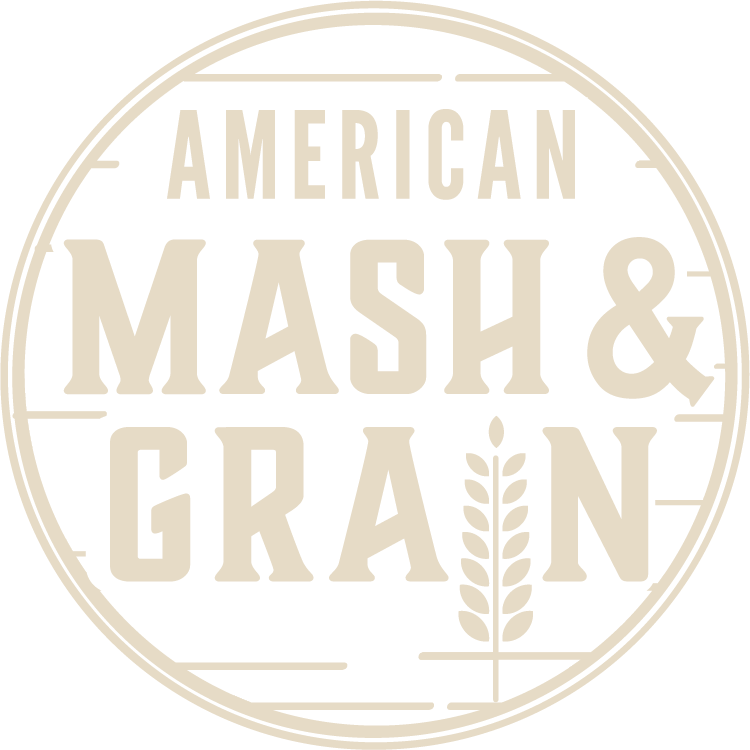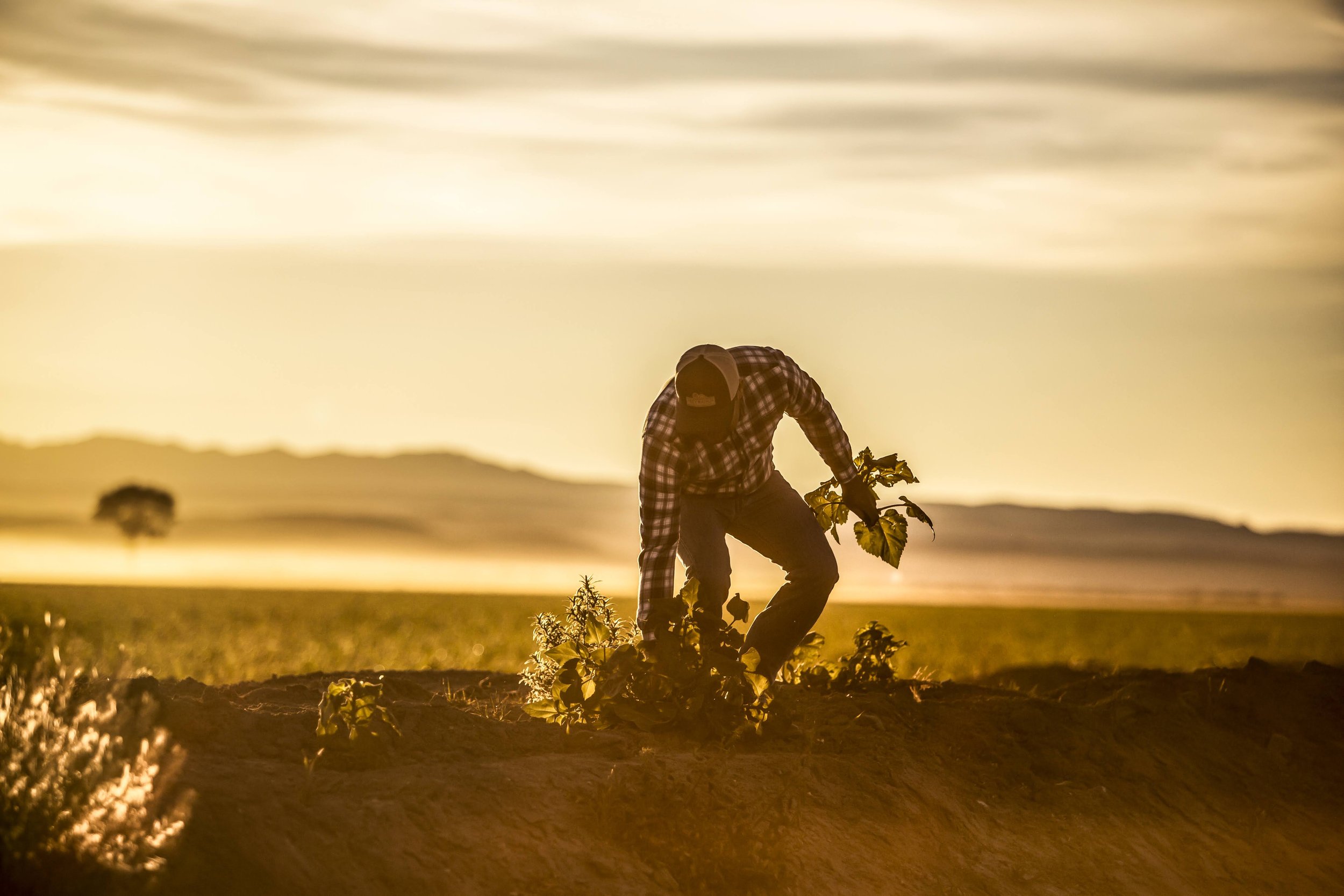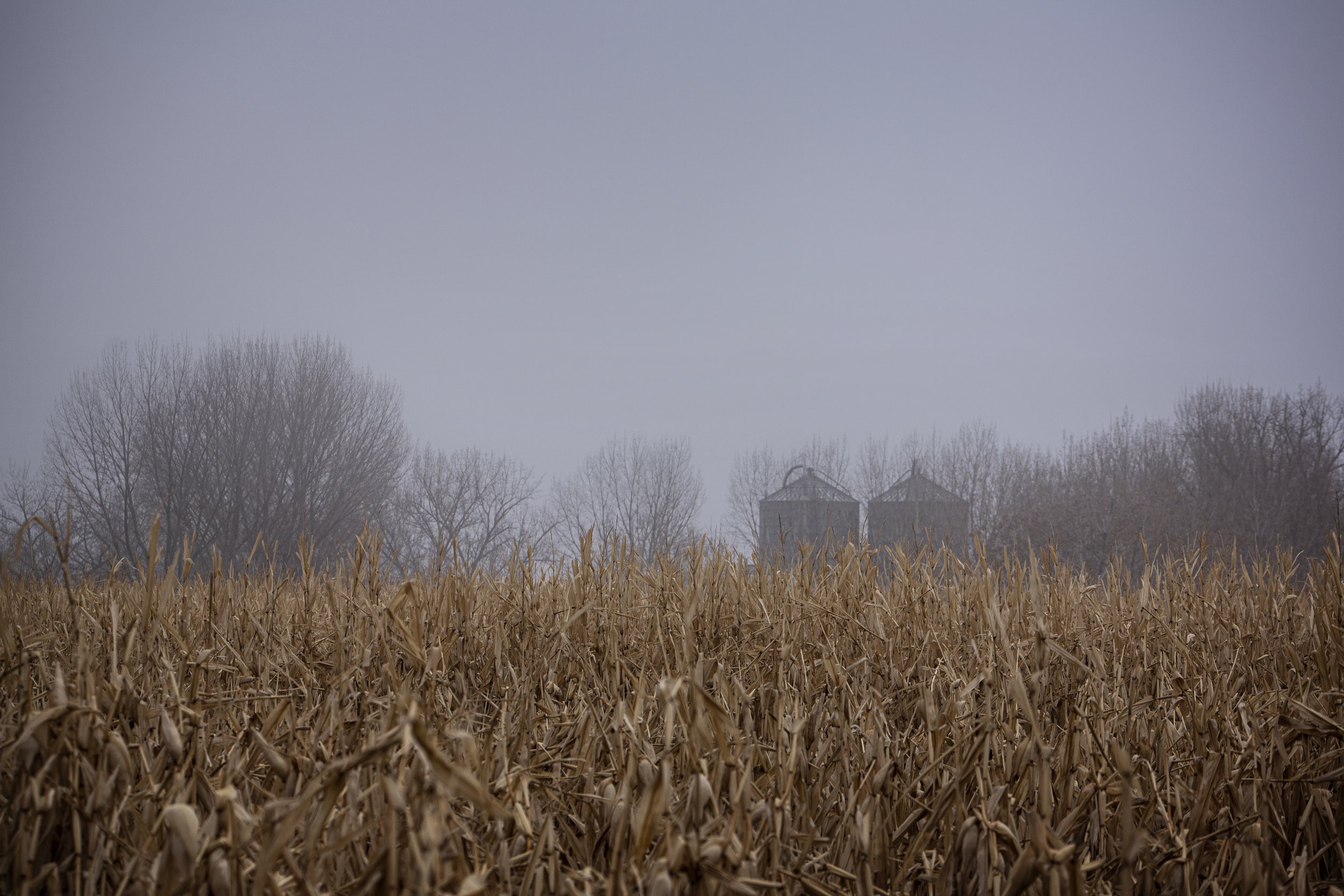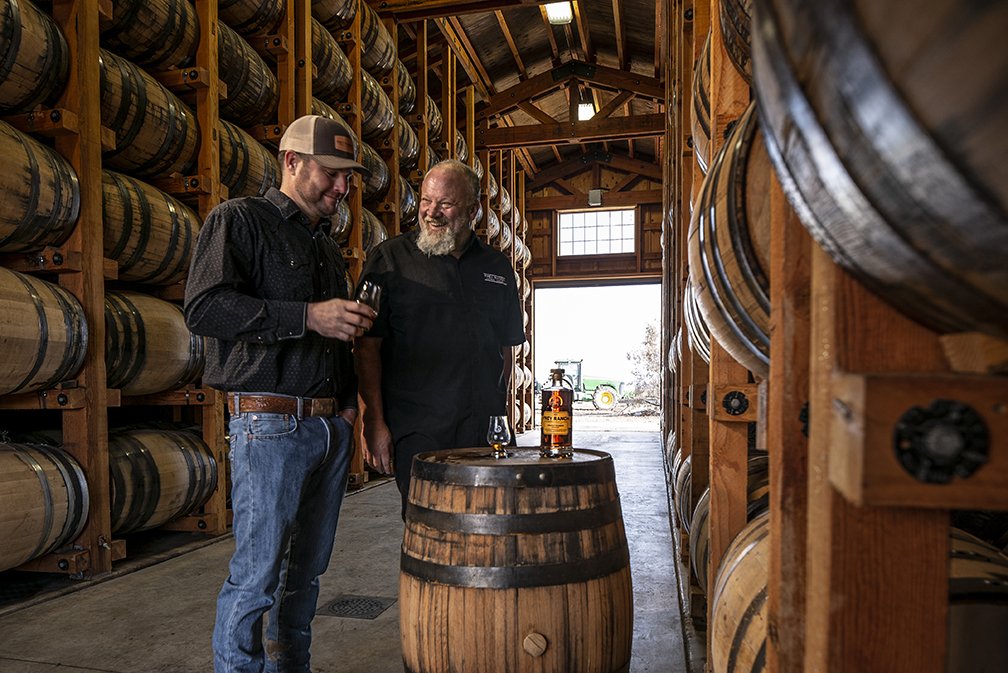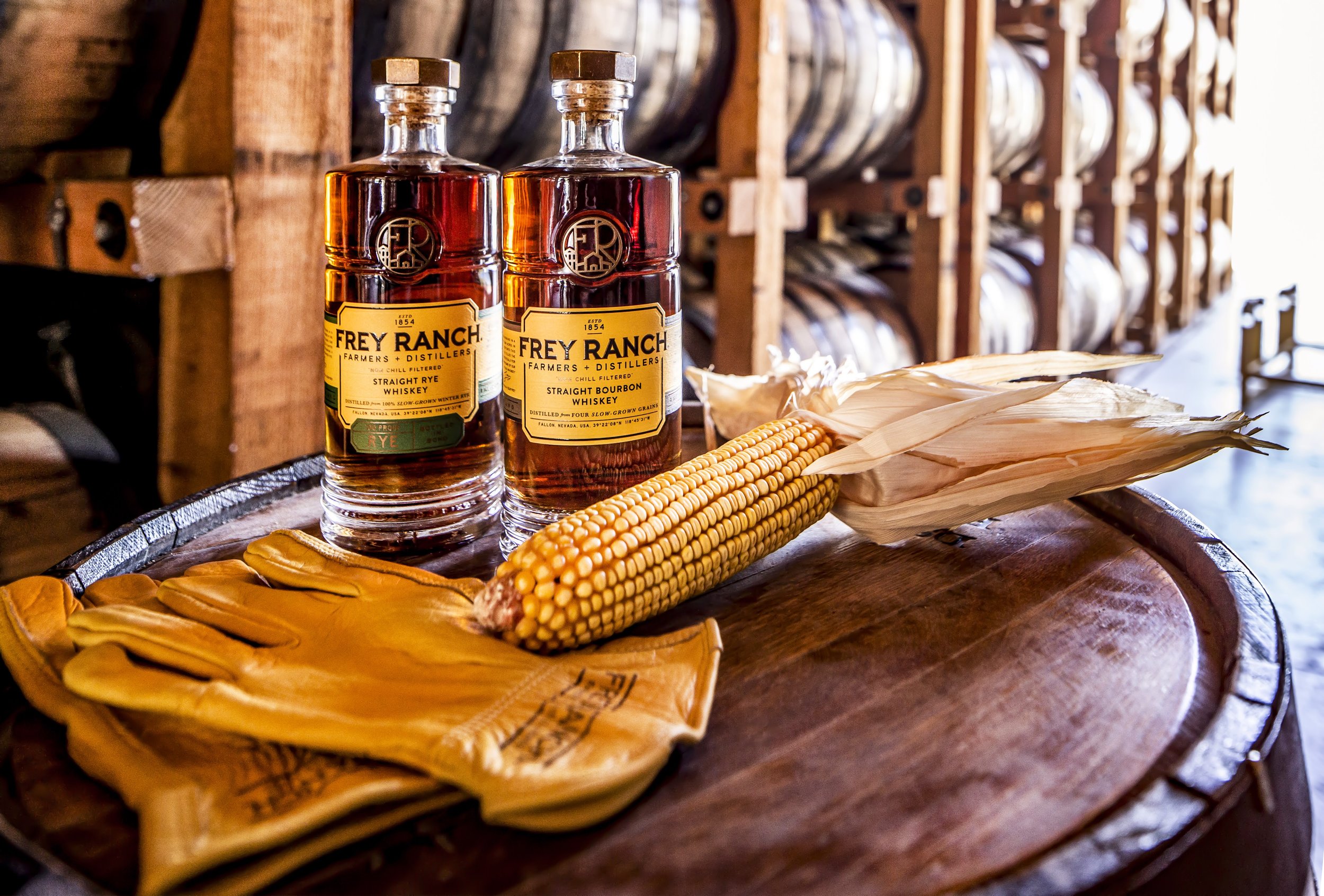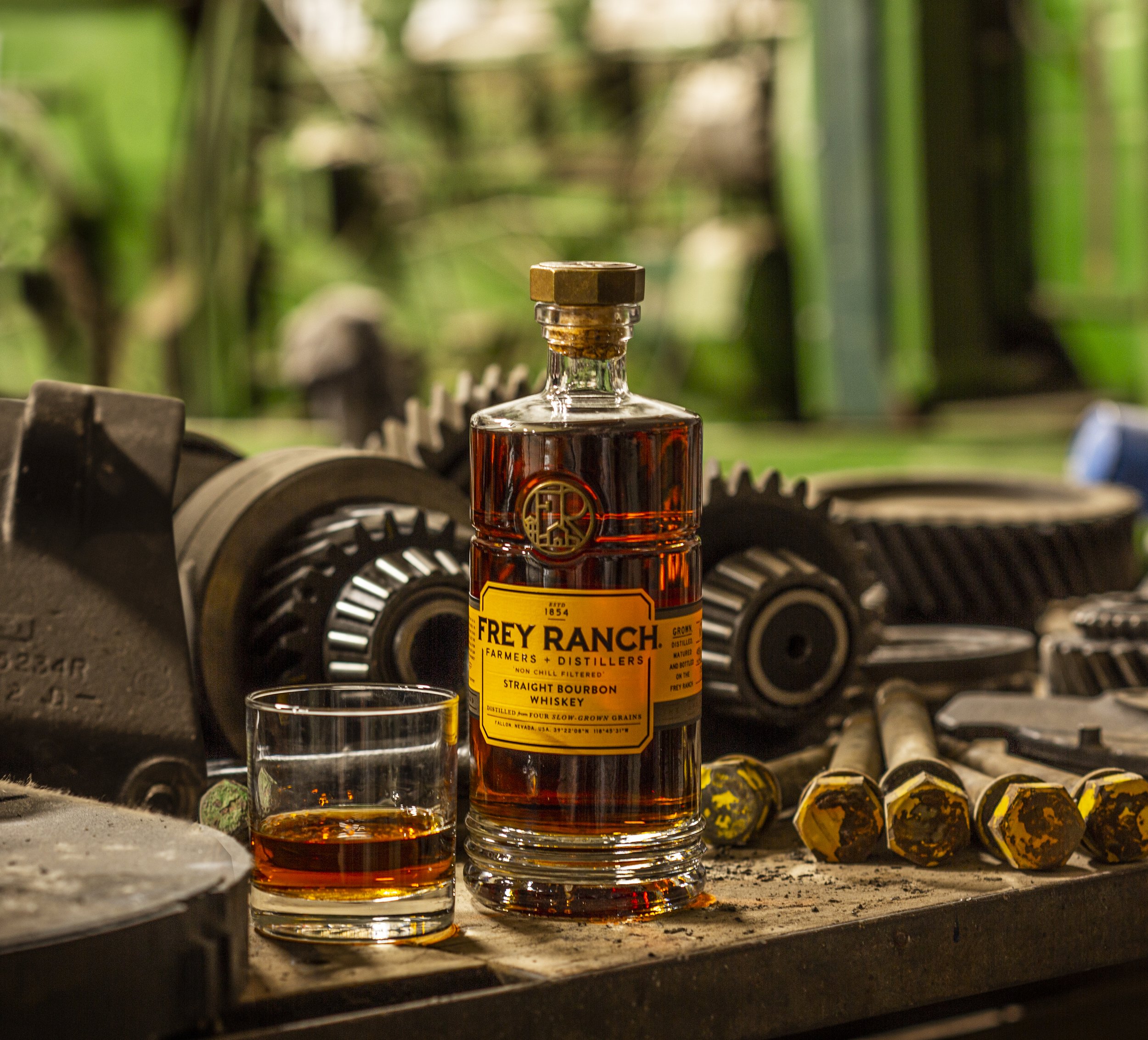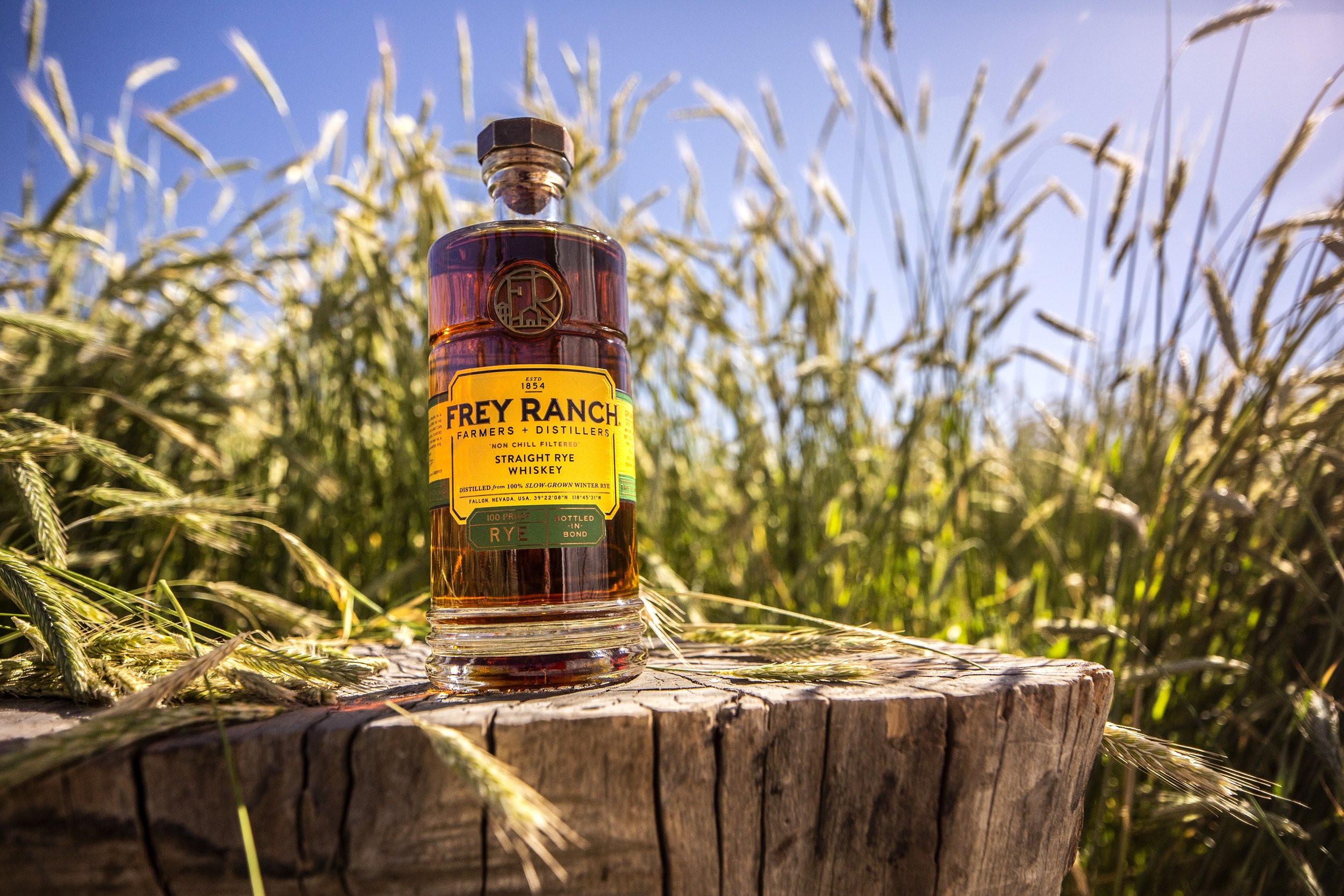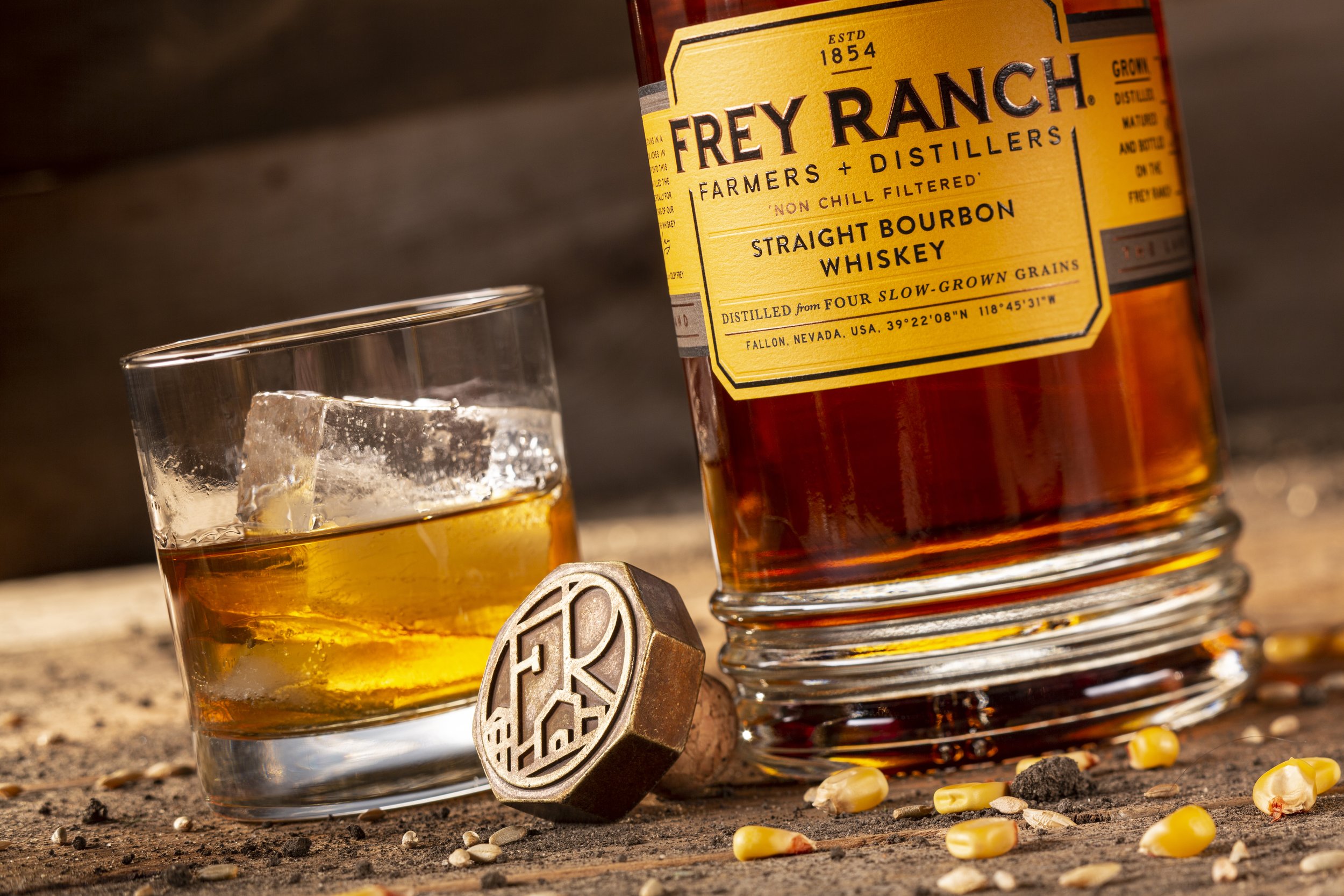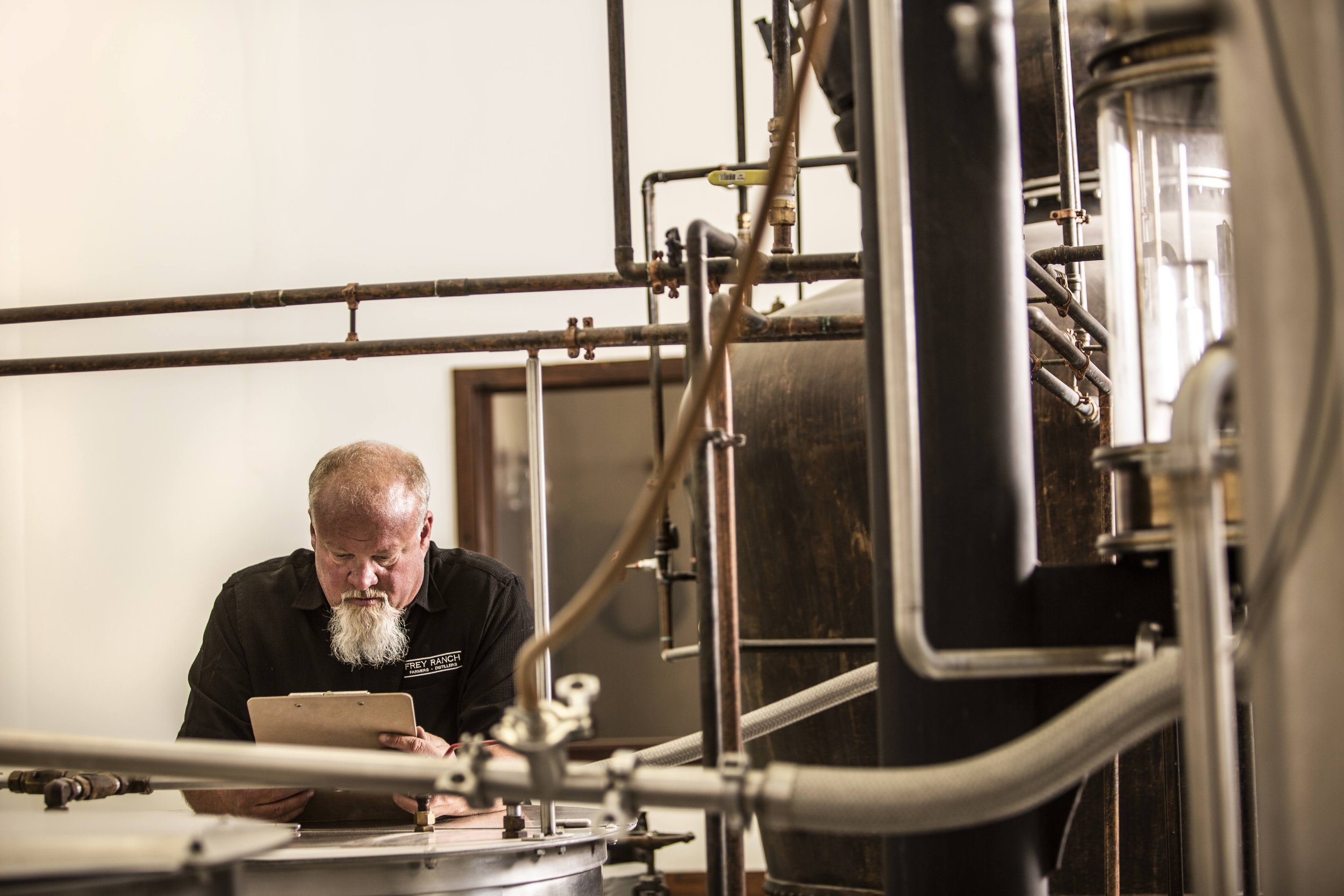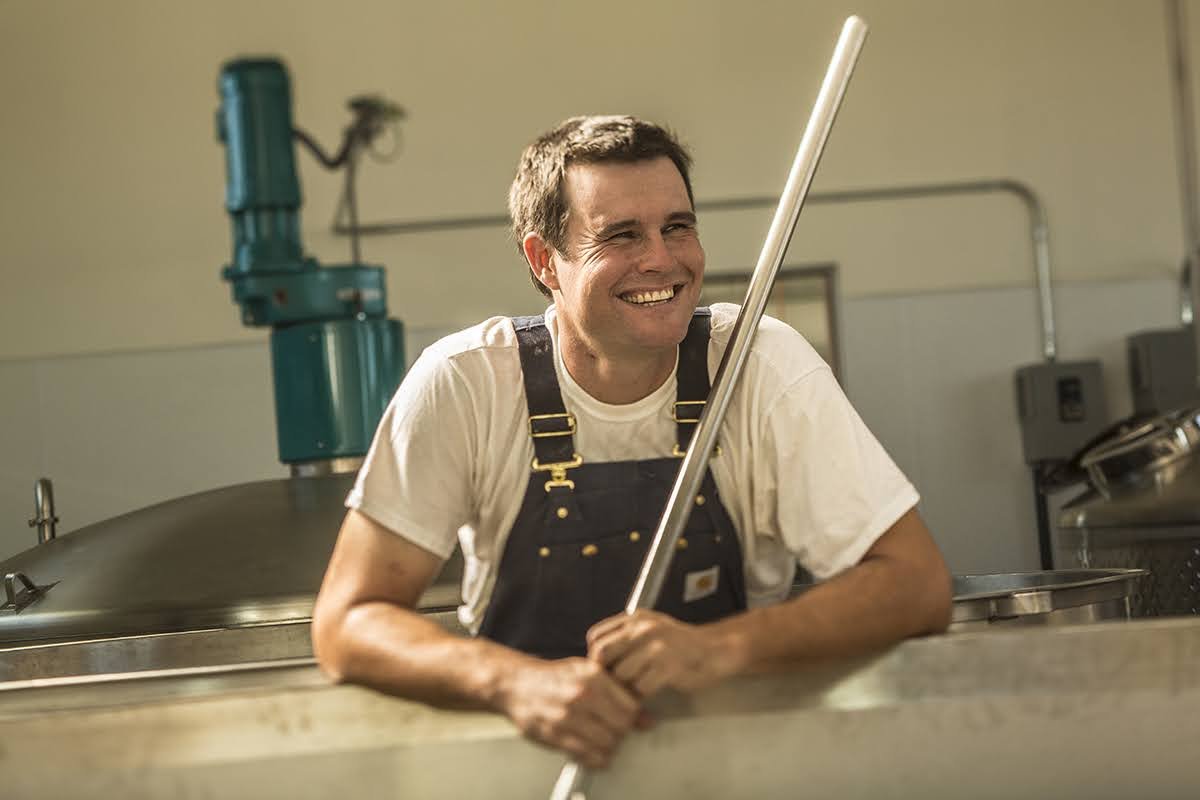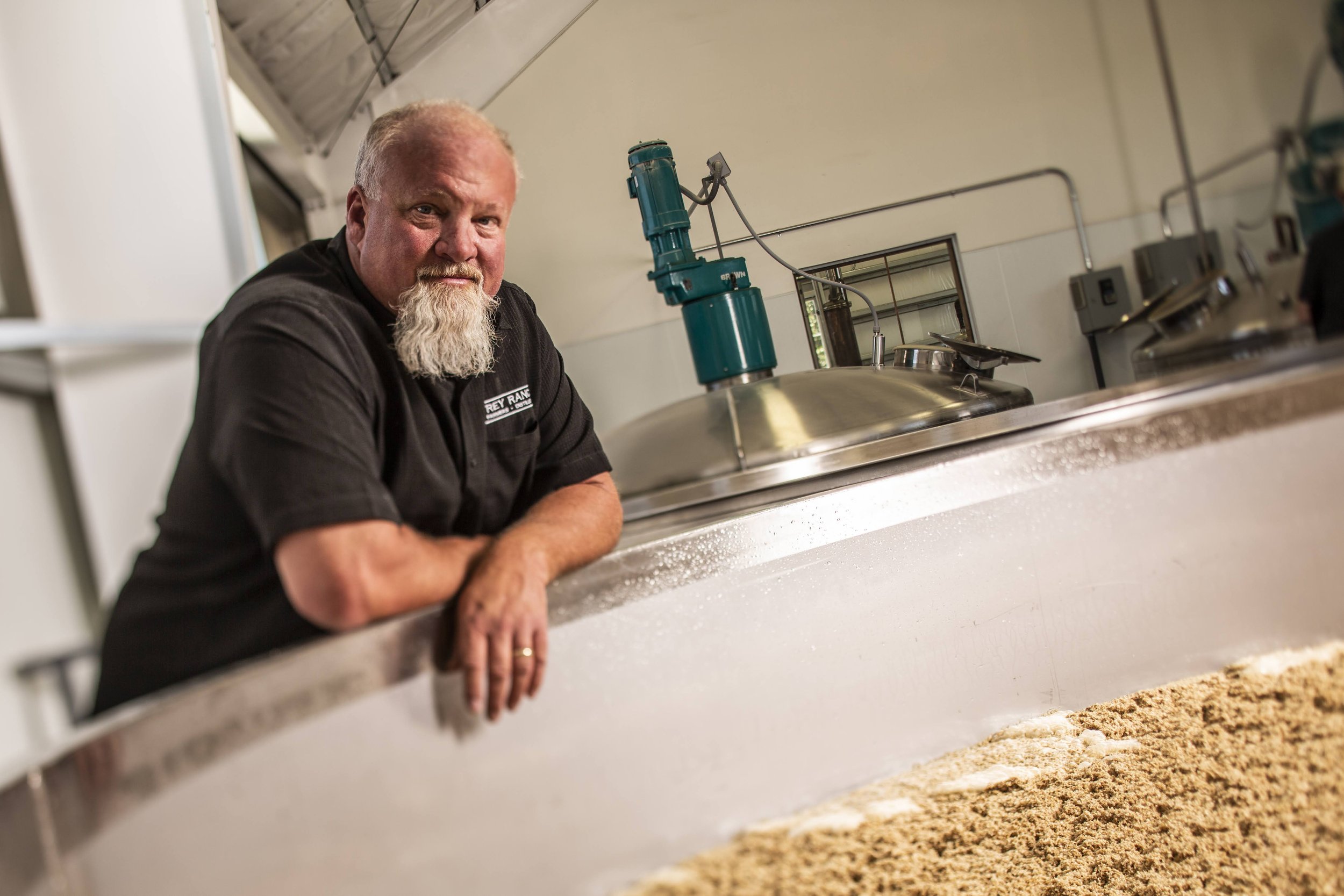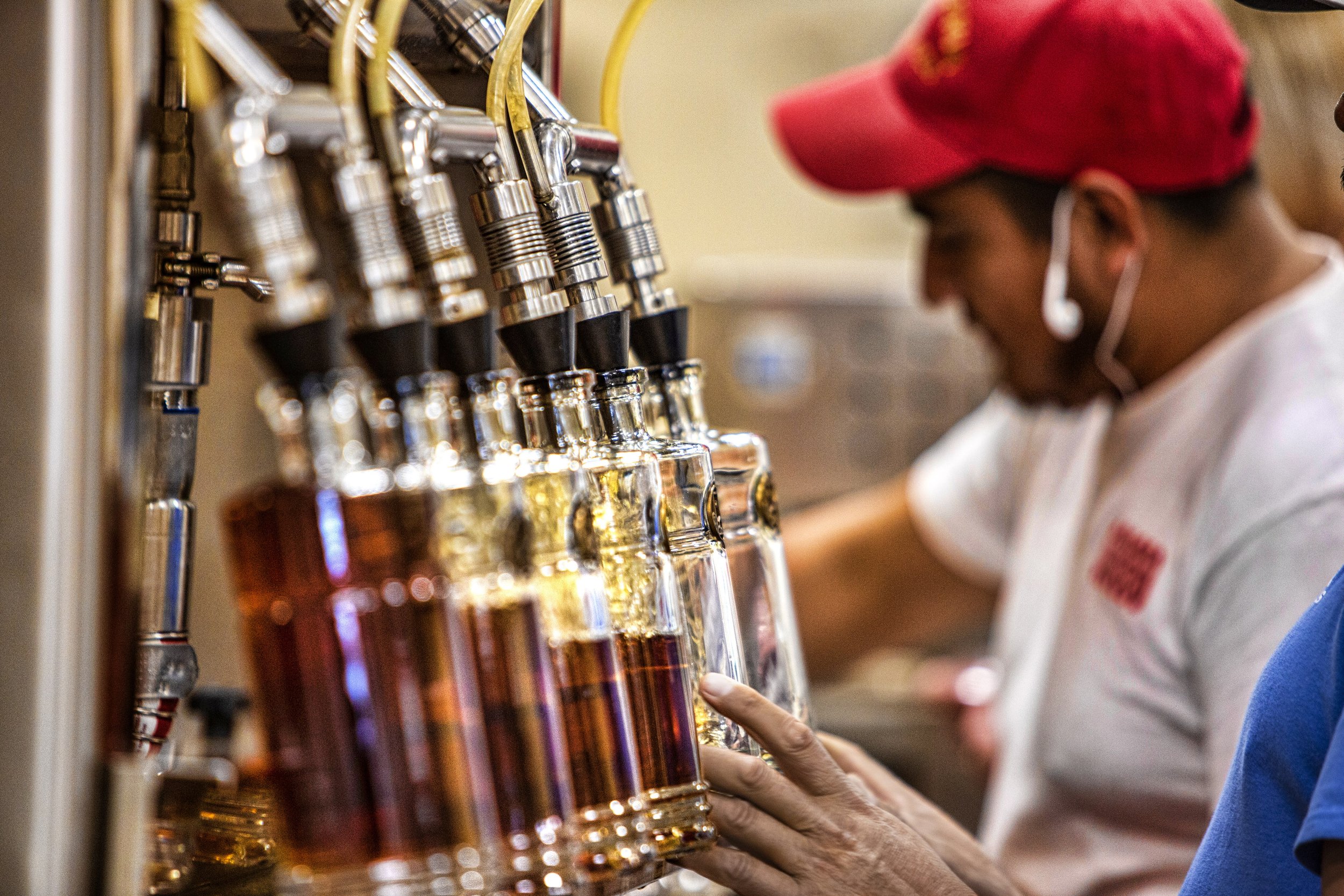Frey Ranch
By Meghan Swanson
There’s a moment in the breakout television show of 2020, Ted Lasso, in which the titular character epically crushes the show’s villain at a crucial game of darts. In the scene, he quotes American poet Walt Whitman - “Be curious, not judgmental.” The bad guy could have saved himself the humiliation if he’d taken the time to get to know Ted (and his killer dart game) instead of assuming he knew everything about him at a glance. When we think of an American farmer, we might picture Carhartt jackets, John Deere tractors, faded blue jeans, and endless fields. Perhaps Paul Harvey’s unforgettable “So God Made a Farmer” speech (or the truck commercial it was laid over). Some might even think of sad, sepia Dust Bowl photographs of Americans headed west with all their belongings piled on the family truck. All those things certainly have their place in farming life and its history, but if you don’t look closer at today’s farmer, you’ll miss the laser-guided equipment, the ingenious inventions built from scraps, the arcane workings of crop science, and their indomitable optimism and entrepreneurial spirit–not to mention their brilliant work emerging in the world of whiskey. If you already think you know what American farming is, we encourage you to look again. Look at Frey Ranch, working hard in northern Nevada–and be curious.
“We’re a whiskey farm. From the minute the grains are planted in the dirt, in the soil, they’re destined to be whiskey.” - Colby Frey
Colby Frey’s family has deep roots in Nevada; quite literally, as they’ve been farming there for 165 years. His four-times-great-grandfather bought the first Frey Ranch in 1854, ten years before Nevada itself even became a state. That original property, now called Ranch One, was the first ever deeded piece of property in the state. Over the five generations the Freys have been farming, the location of Frey Ranch has changed occasionally, but has always been in northern Nevada. Frey Ranch’s current location was purchased by Colby’s grandfather in 1944. Grandpa Frey lived in a dirt dugout with a tin roof while he scraped together every dollar he could in order to get the property. Located in Fallon, Nevada–closer to San Francisco as the crow flies than Las Vegas–the land is still highly valuable. Colby’s father knew they could sell it for a good profit, but could never bring himself to do it. “My dad’s a CPA, but he’s also a farmer. He never really wanted to sell the farm.” Colby tells us. He and his wife Ashley purchased the farm in 2009. “He [Colby’s father] always said if we were smart, we would sell it - but that’s not who we are.” Colby explains. As it turns out, this reluctance to sell would be a massive stroke of luck for whiskey fans.
Distilling wasn’t the Freys’ first foray into the beverage industry. For a time, Colby’s father had run a winery on the ranch. Nevada is a dry place, and grape vines use less water than grain crops. It was a logical idea, but Mother Nature doesn’t always fit with logic. The climate didn’t cooperate, and the various swings in weather year by year made for an inconsistent grape harvest. Fortunately, Colby had another idea. “At the time I liked whiskey better than wine anyways, and…thought, why aren’t we making whiskey out of the grains we’ve grown in Nevada for 165 years?” He asked. That question sparked his distillery dream; he was the product of five generations of farming know-how, had a knack for building things, and had a whole lot of perfect grain at his disposal. Frey Ranch had just become a whiskey farm.
“One of the sayings is, ‘how do you eat an elephant?’ The answer is one bite at a time.” - Colby Frey
Like many craft distilleries, Frey Ranch faced a legal climate that wasn’t friendly to the small distiller. They were issued an experimental distilling license on the federal level in 2006 with the strict understanding that they were not to sell or provide tastings of their product to consumers. Colby had big dreams to sell their whiskey, but for the time being they accepted their limitations and set to learning everything they could about their new vocation. They had grain, space, and ambition, but the next thing they needed was a still. Luckily, Colby and his father both have that knack for building and engineering. “On the farm, we rebuilt old tractors…some of them we bought literally in boxes and had to figure out how to put them together. We built wagons when I was in high school, we remodeled old cars…it really gave me the confidence to like, build the distillery and really do what we do.” says Colby. They turned their hands to building the first still for Frey Ranch. Number one was a pot still made of aluminum; still two was made of stainless steel and copper, and still three was all copper. “Almost all of it [the metal] was scrap that was lying around, or it was from the winery, or whatever.” Colby reveals. “As farmers…you have to be really thrifty. There’s not a lot of money in it, and so we reused a lot of stuff and create things ourselves because we have to. It’s out of necessity, but it’s kind of what I like to do, also.” he tells us.
They began to distill, taking their experimental license literally. “We distilled all kinds of stuff. Whiskey was always our favorite, but we made vodka, we made grappa, we made brandy, we made gin, we made…everything, and it was really fun to do it while we were really focusing and honing down on the whiskey also.” Colby recalls. While they awaited the change in law that would let them begin sharing their work with consumers, they tweaked, tinkered, and tried new things. They experimented with different mash bills and strains of yeast in the distillery, while on the farm they tried different grain varieties, irrigation strategies, and fertilizer management. “It’s kind of, I tell everybody it’s a blessing in disguise, because 2006 til 2013 when we finally got the laws passed and got a commercial Nevada distilling license, it made us really slow down.” Colby explains. The extended ‘practice round’ of being an experimental-only distillery paid off when that commercial license finally came. “In 2013, when we finally got the laws passed, we knew what we wanted and we knew how we wanted to do it.” Colby states.
After going through three stills, Frey Ranch was ready to get their hands on one they hadn’t built themselves. Colby was bullish on the granting of their commercial license. “We started the distillery a little bit before the laws were passed, because I was pretty confident. I ordered our stills and everything before it had even passed.” he shares. He personally prefers a pot still for the ease of taking heads, hearts, and tails cuts, but sees the advantage of volume provided by a continuous still. To try and get the best of both worlds, Frey Ranch does their stripping run through a column still to boost their output volume, but instead of running that through a doubler (as is most traditional), they do a second spirit run through a pot still to maintain complete control of the cuts. “When we had our still built…by Vendome Copper and Brass Works, and it was the first one they ever made that had a continuous still and pot still that kind of worked in unison together. They built it in the factory, they took two pictures, they disassembled it, they sent us these two pictures, and we literally had to put it together looking at these pictures.” Colby recalls with a bemused grin. “It was like a big jig-saw puzzle, basically, it was really fun for me.” he explains.
Colby’s father, a man of many talents, is an AutoCAD whiz. This allowed the Freys to do almost everything else for the distillery’s build on their own. Colby’s father engineered their steam lines, cooling lines, electrical lines and more, and then they installed all those elements themselves. They hired a contractor to help with the larger parts of the building, but they assembled and installed their Vendome still themselves. “He [Colby’s father] would always say how proud my grandpa would be of us, of what we’re doing, you know…it’s just kind of who we are. The building part of it is really fun.” Colby reminisces. Those three original, DIY stills have since been cannibalized for materials for other projects, or put to new and different uses. Ashley and Colby recall using one to make pickles and giving one to a cousin to be used in his hemp business. The Freys’ thriftiness translates into a more sustainable style of distillery. “We didn’t do it because it’s the trendy thing to do, or to market it in that way.” Colby says of their habit of reusing and repurposing material.
“Our products, when you buy them in the bottle, we have total control over it until you take it home. From what we call ‘ground to glass’.” - Colby Frey
A bottle of Frey Ranch bourbon begins as a seed, nestled beneath the soil in a Frey Ranch field in the fall. The seed is allowed to grow slowly under its earthen blanket all winter long. “We don’t rush it, we grow it the right way. Most of our grains are winter grains, you know, wheat, rye and barley–obviously, you can’t grow corn in the winter. There’s no winter variety of corn.” Colby explains with a laugh. This is a deliberate choice to encourage a more robust adult plant. “What happens is the grain spools out, which means it gets this really good root system all winter, it grows really slow, and then in the spring, it has this great root system established and it can start growing up. Whereas, if you planted in the spring, you’re starting from nothing.” Colby asserts. Once those slow-grown, sturdy crops reach what Frey Ranch has deemed their peak, they are harvested, destined for the mash cooker. “Traditionally, we almost always harvest spring grain almost the same time as we harvest winter grain, but winter grain is almost always better.” Colby tells us. To Colby and Ashley, that difference in quality means a great deal. “I tell everybody with better inputs you end up with better outputs. So by growing it ourselves, we can make better quality.” Colby summarizes.
They’re really not kidding when they say ‘ground to glass’; if there’s anything they want to do with their grains, they do it themselves right there on the ranch. They malt their own barley using a steam tank to encourage germination and then a drum where it’s dried to 6% moisture, rendering it stable for storage in silos. To Colby, this process is just another bite of the elephant. “Malting is essentially–you’re sprouting the grain. Grain is a seed. You’re sprouting the grain and allowing it to grow to a certain point, and then you stop any future growth by drying it. Well, we’re farmers. That’s kind of what we do in the field.” he says with a shrug.
When Colby wanted to try out a Scotch-style whisky, he had to tackle the question of how Frey Ranch could do peat their own way. Traditionally, peat is bricks of decomposed plant matter thousands of years old, sliced out of a Scottish bog and used to smoke the grain that goes into Scotch whisky. Northern Nevada is lacking in Scottish peat bogs, so Colby got creative. He didn’t have bogs, but he did have plant matter–they are a farm, after all. He mixed together decomposing corn stalks, fine flour off their mill, and water, then put it all under a hydraulic press to make ‘peat’ cakes. This homemade peat goes into the bottom of a silo he put together specifically for smoking, filled with barley. The peat fire is lit and a fan draws the smoke up through the silo full of grain. The system is efficient, smoking up to 25 tons of barley at a time and making use of otherwise useless vegetation.
It’s the kind of challenge that demands to be met with creativity; and it’s Colby’s favorite part of the job. “That’s what’s fun for me, is to create those kind of things.” he says, smiling. Frey Ranch’s production is about 80% bourbon whiskey, 15% rye whiskey, and 5% percent of what Colby calls the ‘fun stuff’. They have experimental whiskeys all over the map; in addition to the Scotch-style whisky, they’ve tried a smoked oat and rye, single-grain mash bills of 100% wheat, corn, rye, and malted barley (respectively), and what Colby calls a ‘quad-malt’, where all four of those grains are malted. “I tell everybody it’s 5% of our production, but 95% of the fun.” he jokes. When it comes to experimenting creatively with things like different types of casks for aging, his attitude is ‘never say never’ but interest is low. “Our goal in the distillery is to really showcase the grain that we’re growing.” he explains. He’d rather play with mash bills, grain varieties, and malting techniques.
After that Frey Ranch grain is processed and distilled, it’ll go into a barrel for aging. Frey Ranch uses a combination of barrelhouses, some palletized and some the more traditional rickhouse, stacked high with fat barrels patiently waiting to be tapped. Frey Ranch doesn’t insulate their barrelhouses or control the temperature, letting Nevada’s climate work its magic on their whiskey. “We’re really fortunate, here in Nevada we have four distinct seasons. We go to Kentucky and they all talk about they have all four seasons, and a lot of times me and Ashley will be laughing, because we have all four seasons in one day sometimes. I mean, the weather here is wild.” Colby tells us. With temperatures that can range from 0℉ in the winter to 109℉ in the summer, the barrels will naturally expand and contract as the weather changes. One thing they do regulate, however, is humidity in the barrelhouses. “We’re in the driest state in the nation, we have very low humidity. Low humidity, there’s two things: you lose a lot of angel’s share, lose a lot of volume, but you also get better quality at higher humidity.” Colby explains. A very dry storage climate will suck away more water than alcohol from the barrels, leaving it at a higher proof when it’s time for it to come out and be bottled. The distillery would then need to add water to bring it to the desired proof, diluting the whiskey and lowering its quality.
Ashley sums up the Frey Ranch ground-to-glass approach. “For me, being a part of the office work during the week and seeing Colby out on the farm all week, and then working in the tasting room on the weekend, and being able to pass the bottle off to the consumer and…know that none of these ingredients have ever left our possession. And I know that, I know where they were grown…and the quality of grains and what went into growing them…and that’s what we’re very proud of. That’s what keeps us motivated all day.”
“Here on the farm, people always say to us, like ‘Oh, Frey Ranch, what kind of animals do you have?’ and I’ve said ‘Oh no, we don’t have animals.’...that’s kind of where it came from. One day I was thinking, we raise whiskey.” - Ashley Frey
Frey Ranch clearly has a rich history and many unique qualities they could draw on for brand inspiration. Despite that, when they first got started they didn’t have any ideas in mind as far as branding went. “I think that’s where a lot of distillers or craft brands go wrong. They have this idea that they want a distillery, and right away they’ve got like, a logo and a bottle and a label design but they don’t even have a product to put in there. I think we did it completely opposite, we started with the grain…and then we built the distillery, and then we properly aged the bourbon. We didn’t start even working on the packaging until the whiskey was in the barrel for four years. By that time, we had a clear path of…this is what’s important to us and this is what we want to share with people.” Ashley explains. “We had toyed around with a lot of different designs, because I think there are so many parts of our story that are so important.” Colby adds. The agricultural roots of the Freys, Colby’s entrepreneurial spirit, and the Frey knack for tinkering with and building tractors were all considered as thematic elements. “Here’s where I’m really lucky: Ashley actually has her degree in PR and Marketing. So it was like, perfect for me because I’m not–farmers aren’t marketers.” Colby confesses with a grin.
Instead of drawing just from the past, Ashley and Colby chose to look ahead. “The theme of our packaging was a modern take on farming and distilling.” Ashley tells us. “It was less about the prior generations and more about our generation and what we’ve done with the land and how we’ve evolved the family farm, and that was kind of the A-ha! moment. Not to play down anything Colby’s ancestors have done and where his family had led him–and us–to this point, more like we’ve taken it from this step and really built it up.” she explains. They avoided overdone sepia-toned, scrollwork-heavy packaging in favor of a vibrant yellow label and bold, clean black print. “The beautiful yellow color actually represents the corn that grows in the field, so–” here, Ashley pauses, sending Colby to search for an actual ear of corn to demonstrate. “It’s that same beautiful, free-range yellow so it represents the corn that grows.” When she holds the golden ear next to the Frey Ranch bottle, we have to agree the match is perfect. The label’s shape wraps the bottle like a belt, with a rectangular, buckle-shaped portion on the front bearing the Frey Ranch name proudly. This represents an actual belt and buckle passed down to Colby from his grandfather (which he still wears regularly), a subtle nod to his roots. The bottle topper is in the shape of a bolt, a frequent sight on the farm. Etched into the bottom of each bottle is the Frey family creed - be good to the land, and the land will be good to you.
“Anywhere you go in the world, agriculture is different. So really understanding our soils and our crops and everything here in Nevada is really important.” - Colby Frey
Colby, Ashley, and their team work very hard to be good to the land on Frey Ranch. “That’s just the Frey family motto. We don’t take without giving back.” Colby says. They have made deliberately sustainable and eco-friendly choices in the name of preserving the land that sustains them. Even waste products have a purpose on the ranch; spent grain solids get hauled by a John Deere tractor to the dairy farm next door, where they’ll nourish the neighbor’s cows. The spent grain liquid is poured onto the fields, balancing the natural alkalinity of the soil and improving it for future crops. Instead of using glycol or antifreeze for cooling water, they use a natural reservoir located beneath the farm to cool and recirculate the water through their systems, saving hundreds of thousands in electricity bills. And of course, growing their grain onsite ensures a fairly minimal carbon footprint in comparison to distilleries that fly their grain in from around the world, or even truck it from the next county over.
In addition to making choices that are good for the land, they strive for peak efficiency. This is where those GPS-guided implements come in; using data from satellites orbiting the earth, a home control unit on the ranch will send orders to the big tractors and their wide implements in the fields. A 25 to 30 foot implement is difficult for a human to drive with precision, resulting in overlap that adds up to lost efficiency over time. With the accuracy of GPS, Frey Ranch saves man hours. Though these huge tractors use more diesel than a small tractor, Colby has crunched the numbers and reveals that they achieve three times the output of a small tractor, while only using one and a half times the amount of diesel. GPS also guides their scrapers, which use lasers to precisely measure the necessary slope of a field and adjust accordingly to send the irrigation water evenly over and down the field without pooling or missing sections.
Even their efficient and sustainable practices can’t combat every challenge a farmer faces, however. “You’re planting a seed in the ground, hoping that it’ll grow, and at the end of the season you have one harvest you pretty much have to pay your bills for throughout the entire year. And so it’s not like, if I screwed up, no big deal, I’ll just plant it again next month. You have to wait an entire year before you have another opportunity.” Colby explains. Drought, floods, labor shortages, supply prices, pests and more can ruin that harvest so full of hope. Asked whether being a distiller or a farmer keeps him up more at night, Colby’s attitude is sanguine. “If I let the negatives in everything, the possibility of having a drought or the fertilizer prices, all the different factors that every year farmers have to deal with…I think I’d go crazy. So that’s why you just say ‘It’s gonna work out, everything will be ok.’ and go to sleep, you know?” he says with a chuckle. “Sometimes it drives Ashley crazy, but to be a farmer, you have to be an optimist always.” he advises.
“It’s not about the problem, it’s how you overcome it and what you do to overcome it. So that’s what we did.” - Colby Frey
When Colby looks at the time it took to get to Frey Ranch Bourbon as it is today, he’s not necessarily looking at it from the perspective that you might. Yes, seven years is a long time to experiment and play around before ever going commercial, but in the grander story of the Frey family, especially through a farming point of view, that’s not so very long at all. “In agriculture, you’ve got to have years to be able to experiment because every season is different.” Colby says. He was willing to wait for his bourbon to be perfect. “From the beginning, we said we would not release a whiskey that was under four years old.” Colby reveals. When they did get around to letting their Straight Bourbon and Straight Rye out into the world, it was in an inadvisable season and, unfortunately, just months ahead of the emergence of the COVID-19 pandemic. “We did release it in December of 2019, only in northern Nevada, right? Our distributor at the time said it’s a death wish to release a brand in December.” Colby recalls. ‘OND’, or October November December, is the busiest time of year in the alcohol industry. “He said ‘you’re not gonna get anybody’s attention…don’t do it.’ Well, we did it, and it was the best release that they ever had.” Colby grins as he recalls the success.
Frey Ranch’s whiskeys were flying off the shelves, forcing distributors to pick up more cases practically every other day. When Frey Ranch expanded to the Las Vegas area in February of 2020, they enjoyed a similar frenzy. Because of their ground-to-glass principles and commitment to aging at least four years, they had a limited amount of inventory to work with. They opted to focus on on-premise sales in southern Nevada, putting their whiskey in bars and restaurants instead of shops. “We made it in 300 locations in one month. And then in March of 2020, every one of them got shut down.” Colby says in a rueful tone. “As farmers, we’re really used to having to–and I hate the word–pivot, but like, I mean, you have so many different factors…it’s almost like you’re constantly getting kicked in the nuts.” he jokes, laughing. Colby’s indomitable optimism and the hard work of their team steered them through, and so did the quality of the whiskey. Their Straight Rye took home a double gold from the San Francisco World Spirit Awards, earning a spot in Whiskey Advocate’s top 10 in their Fall 2020 buying guide. “Which was really cool because there’s like 200-something entries…and it said, ‘Our top 10 whiskeys hail from Kentucky, Tennessee, Nevada, Scotland, and Ireland.’ I thought, how cool was that, to have Nevada next to all these other countries and states that have had hundreds of years to get their stuff together? That was a big, like a big honor for me.” Colby stresses. Their bourbon also took home double golds, and they netted one additional gold and several silvers. The Frey Ranch team pivoted, though Colby hates to call it that, and refocused their efforts on off-premise sales in Nevada. They managed to meet their sales goals in 2020 despite it all, and have exceeded them in 2021.
As of this writing, Frey Ranch whiskey is available in both Nevada and neighboring California. “Right now we’re only in Nevada and California because we want to do a good job at where we’re at.” Colby explains. Bourbon fans in other states needn’t worry long, however; Frey Ranch made, according to Colby, ten times as much whiskey in 2021 as it sold. “We’ll go to different states as we have more product available. We want to make sure we take really good care of the markets that we’re in.” he states.
“Just in agriculture, just to grow commodity crops and sell them, there’s not a real future in that. By creating a value added, hopefully it’ll make it worthwhile for our kids to continue on the farm. And distillery, now.” - Colby Frey
Farmers are a far more adaptable group than they tend to get credit for in America’s view. From the Medieval European farmers who first adopted the horse collar in exchange for the flat, windpipe-choking harnesses of before to the American farmers of the early 20th century trading horse power for tractor power, they’ve embraced innovation. Colby and Ashley Frey are examples of the relentless optimism and ambition that fuel the sort of person who can endure every curveball life and Mother Nature throw at them and still believe in–and achieve–success. Colby would like to see more of it, and support others like them. “I’d love to be in all 50 states and be at the forefront of the farm distilling movement, because there’s several farm distilleries that are coming online right now. I really want to be at the front of that and I want to be able to help them if I can or they need it. I want to help them create a better product because it’s just like Napa Valley. They are all successful because they helped each other create better wine.” he says. He and Ashley have a goal to uplift their entire industry, and are ready and willing to help others taking the same path they did. Closer to their hearts, they embody Frey family values and express a hope cherished by many a farmer over the millennia. “We want to take really good care of the soil, our environment, everything because if we don’t, we don’t have a future as farmers, and our goal is to give the farm to our kids in as good or better condition than we received it in.” Colby says simply.
Farm distilleries like Frey Ranch are both cutting edge and traditional; they call back to America’s roots as an agricultural powerhouse and at the same time use our latest technology to make their operations better and more efficient. They paint an entirely new picture of both American farms and American craft distilling, emerging from our old impressions of both industries like the hidden image in a Magic Eye book. We encourage you to indulge your curiosity and look deeper into this new hybrid of farming and distilling. Try Frey Ranch’s award-winning, uniquely Nevadan whiskeys, and find out what the convergence of five generations of farming and a modern-day dedication to great whiskey tastes like.
TASTING NOTES:
Straight Bourbon Whiskey (45% ABV)
Nose: Chocolate Dipped Corn Madeleines, Honey Butter, Grassy/Vegetal, Artificial Cherry
Palate: The mouthfeel is delicate and coating with sugar sweet flavors of vanilla icing up front. Mild baking spices evolve through the midpalate leading to a long sweet, spicy and savory finish of barbecue brisket, corn tortillas, tobacco, and charred asparagus.
This is a complex bourbon. The nose is inviting and the palate is constantly changing with new flavors unfolding moment to moment. The transitions are fluid and complimentary, like new colors of paint being added to a canvas.
Bottled in Bond Straight Rye Whiskey (50% ABV)
Nose: Bread Pudding, Fresh Crisp Apples, Oak
Palate: Similar to the Bourbon, the mouthfeel remains delicate with strong cinnamon, and subtle berry flavors up front. The spice flavors intensify through the midpalate leading to a long finish of black pepper, rye toast, and oak with a surprising and refreshing lingering flavor of red grapes.
A lovely rye whiskey with a few surprises. The mouthfeel is very delicate, making for an easy drinking experience which is not always expected from a 100 proof rye. The typical cinnamon and black pepper rye notes are there, but the fruity sweetness that persists from the front of the palate through the finish is unique and welcoming.
